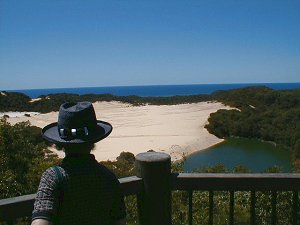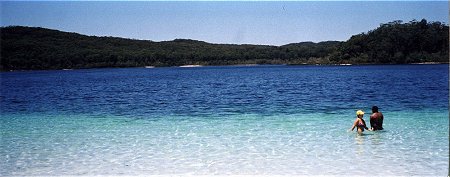 Lake Wabby- a spectacular view of the lake, sandblow and the Pacific Ocean. |
 Lake McKenzie- Some call it the "Blue Lake" for some reason or another. Note the sandy beaches on the other side of the lake. Bigger than Texas?? |
Day 3
This is where we see all the tropical scenery without the heat and bugs, that's because we are in the Temperate Zone. A short run South along the beach brings us to the inland track which takes us through more eucalypt forest climbing high on a range. Remember though that this is all sand and we're on our way to a lookout that will show us the Pacific Ocean and another sand blow. Similar to Knifeblade, this one is slowly engulfing the forest and also, slowly but surely, fill in the deepest lake on Fraser Island, Lake Wabby.
Now it's on the track to, without a doubt the most beautiful lake in Australia, Lake McKenzie. Of the 40 or so freshwater lakes on Fraser Island, this is the pick of them for size, beauty and accessibility. This has to be the best swim you could ever have. The sand is as fine as talcum powder and the water so clear that you can see your toe nails while your up to your shoulder in the water.
 Lake Wabby- a spectacular view of the lake, sandblow and the Pacific Ocean. |
 Lake McKenzie- Some call it the "Blue Lake" for some reason or another. Note the sandy beaches on the other side of the lake. Bigger than Texas?? |
We have to tear ourselves away from here because it's nearly lunch time and everybody is hungry for one of Julie's world famous picnic lunches. So we arrive at Central Station and head for the picnic tables among the towering hoop pines. Central Station was a large settlement years ago when logging the rainforest trees was big business. Now the logging has been stopped and Central has become a Ranger office, and has a great static display of the past. The giant Satinay trees found here were logged for their unique characteristics, in that they are impervious to marine borer and resist rot. This made them ideal for construction of the Docks in London and the Suez Canal.
Now back to that world famous picnic lunch. It appears that everyone was waiting for us to arrive so that lunch could begin.
The Kookaburras here love cheese-they'll even take it off your plate if you're too slow. |
This Butcher Bird was good enough to let Elizabeth share its seat. |
Central Station has hundreds of the these huge Staghorns growing on the Hoop Pines and it's also the place to discover the "Invisible Creek" Wanggoolba. The whole creek here flows through a gully that is completely covered by the rainforest canopy. Wanggoolba is home for a palm that is descended from the days of the Dinosaurs. When we take people down into Wanggoolba, they feel let down as if we have deceived them. Their first look at the creek and the comments are usually "What's that white scum on the surface". Our answer is usually "That's not a white scum on the surface...that's the white sand bed on the bottom of the creek".
Staghorns are big here |
Wanggoolba- the Invisible Creek |
Tall Piccabeen Palms searching for the sun can be a couple of hundred feet high. |
Strangler Fig- a vine that eventually becomes a tree at the expense of the host tree it slowly 'Strangles" |
Well, the Kookaburras and their partners in crime, the Butcher Birds, have all given the "Thumbs Up" to Julies world famous picnic. Now we must head back along the beach and get some more fire wood at the Ranger Station so we can have a roast dinner after a hot shower back at camp.
What's in the Camp Oven? Where's the thermostat? How hot are those coals? |
Roast Chicken- Finger Lickin' Good- That'd be a great slogan ya know. |
Now, where are those satellites.....